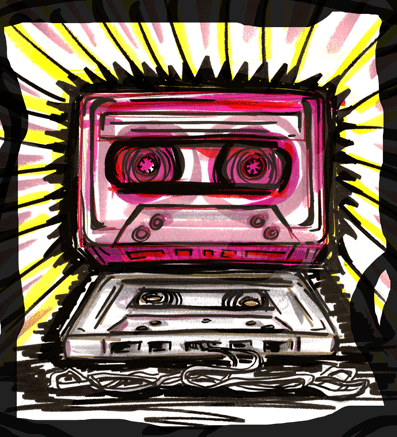Millennials quiver with excitement at the sight of anything tacky, nostalgic or vintage. It became not a question of if, but when a genius and soon-to-be billionaire would begin the audio cassette revival when everyone is starting to realize that vinyl isn’t cutting it like it used to in a generation addicted to convenience.
The benefits of cassette are more than just the cool vintage appearance and throwback to nostalgic pop culture; they are both convenient and musically different than the media that are popular today.
There are quite a few benefits of listening to albums recorded to cassette for both the consumer and the producer. The beauty of an album not only lies in the songs themselves, but also in the composition and organization of the album. The ability to scroll through songs or handpick hits with CD or MP3 players have tarnished the way music is being consumed in comparison to earlier generations.
With the record and the cassette, music can be consumed and enjoyed from beginning to end, giving you the ability to understand the bigger picture and realize the intention of the artist.
Albums are stories and journeys that should be enjoyed in the linear fashion set by the artist themselves. Cassette is much more difficult to skip through, and that is a plus. You are forced into the habit of being a thoughtful music consumer.
The rise of the record can be attributed to many things, but the patience and deeper understanding that can come from listening to the hard work of an artist from beginning to end could create a generation of educated music consumers.
Though you also get these benefits from vinyl as well, the tape proves to be more convenient physically.
The tape can go in your pocket or backpack, and the fear in the delicacy of a vinyl is absent. Tapes don’t skip, and the durability in comparison with CD and vinyl is a bonus. You can listen to tapes on the go and designer tape players will soon be in production. On the whole, the music industry may see a change in the type of music consumers with a growing demand for entire albums on vinyl or tape.
Local musician Micah Erenberg has and currently uses cassette tapes to record some of his music. Though he says the convenience is clearly not up to par with the digital era, the sound quality is much different from that of digital recording.
“Tape is continuous sound. What you record fully exists on tape and on digital, it is broken into tiny pieces. This is the difference of seeing a painting in real life or seeing it on a computer screen,” said Erenberg.
“No matter how ‘hi-def’ you make it, to a computer audio will always be a matter of frames per second.”
The sound on an audio cassette is also more complementary to the sound that is produced by the instruments being played. The ability to pick up and adapt to frequencies allows the sound produced by tape to be ideal and doesn’t require frequency modification in the same way digital recordings do.
“You don’t have to change the sound for it to become pleasing, whereas digitally, you would be modifying the tone of your guitar,” Erenberg added.
Along with the technical aspect of cassette recording, Erenberg highlights the rewarding aspect of the process along with the physical product.
“The most definitive answer I can give for tape being better is the feeling I get when I use it. You feel it in your heart […] When you record a track and then you look at the physical tape and know that you are actually on that tape, it’s pretty amazing and rewarding,” Erenberg said.
“Holding a tape and knowing what you played is physically on it is something you’ll never feel while holding a hard drive.”
Now that cassettes are becoming available at major clothing distributor Urban Outfitters, it is only a matter of time before the appreciation grows with the nostalgia and the wave of supporters start buying music on cassette.
We should all prepare for a wave of cassette parties and romantic boom-box holsters playing your very own mix tape on the horizon.


